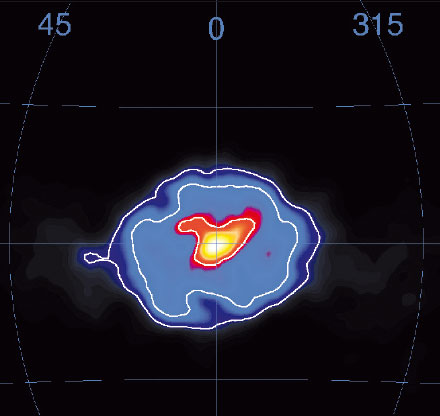A new analysis of diffuse galactic gamma-ray data sets constraints on the initial energy of positrons produced in the centre of our galaxy. This limitation to at most a few mega-electron-volts severely restricts their production sites and in particular the range of masses allowed for a possible origin in lightweight dark matter.

A balloon-borne spectrometer first detected the characteristic electron–positron annihilation line at 511 keV in radiation from the galactic centre in the early 1970s. It was only in the 1990s with the Oriented Scintillation Spectrometer Experiment on NASA’s Compton Gamma Ray Observatory (CGRO) that the distribution of the 511 keV emission could be mapped. A decade later, the improved capabilities of the Spectrometer on board ESA’s INTEGRAL mission revealed a simple circular distribution of emission around the galactic centre with an extension of about 8° in diameter at half-maximum.
The confinement of the positrons to the galactic bulge, with only weak evidence for emission from the galactic disc, triggered new and exotic ideas about their origin. In particular, the idea that annihilation of lightweight dark matter could be behind the positrons ignited much interest (CERN Courier November 2004 p13).
The fact that positron annihilation can result only in gamma-ray emission at energies at or below 511 keV implies that if the positrons are energetic, they have to cool down before annihilating, possibly leaving an imprint at gamma-ray energies above 511 keV. John Beacom and Hasan Yüksel from Ohio State University have now reconsidered this and used gamma-ray data in the mega-electron-volt range to constrain the injection energy of the positrons.
Previous work considered only internal bremsstrahlung radiation associated with positron production as a possible cooling mechanism. However, Beacom and Yüksel also took into account the in-flight annihilation of energetic positrons in the interstellar medium as they lose energy by ionization in matter.
After calculating the expected gamma-ray spectrum through this mechanism for mono-energetic positrons of different energies, Beacom and Yüksel compared it with gamma-ray observations from INTEGRAL and CGRO. They found that the in-flight annihilation signal from positrons injected with energies above about 3 MeV would produce a detectable excess in the gamma-ray emission of the central 5° diameter circle of our galaxy. Such an excess is not detected and this strongly limits the initial energy of the positrons.
At lower energies, they noted that there is a hint of an excess in the INTEGRAL data in this region between 0.5 and 1 MeV. If confirmed by observation, this could be the first detection of in-flight positron annihilation.
The finding that positrons annihilating in our galaxy cannot be produced insite with energies above a few mega-electron-volts has been independently confirmed by P Sizun and collaborators from Dapnia, Saclay, using similar arguments. This severely limits the possible energy of any lightweight dark-matter candidate. However, these authors stress that it is premature to exclude this hypothesis, because the main constraints on the continuum gamma-ray emission in the mega-electron-volt range come from measurements by the past CGRO mission rather than INTEGRAL. Further INTEGRAL observations are required, as well as a reassessment of both statistical and systematic uncertainties on fluxes in the CGRO maps.
Further reading
John F Beacom and Hasan Yüksel 2006 Phys. Rev. Lett. 97 071102.
P Sizun et al. 2006 Phys. Rev. D 74 063514.








